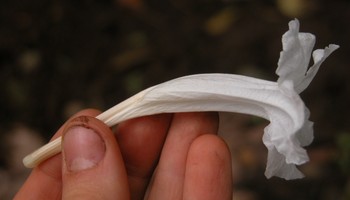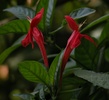Ebracteolate clade
Erin Tripp- Ruellia adenocalyx Leonard
- Ruellia alboviolacea Lindau
- Ruellia amoena Sesse & Moc.
- Ruellia beyrichiana (Nees) S. Moore
- Ruellia bulbifera Lindau
- Ruellia densa (Nees) Hiern
- Ruellia donnell-smithii Leonard
- Ruellia eriocalyx Glaz.
- Ruellia erythropus (Nees) Lindau
- Ruellia foetida Willd.
- Ruellia geminiflora H. B. K.
- Ruellia hapalotricha Lindau
- Ruellia hookeriana (Nees) Hemsl.
- Ruellia humboldtiana (Nees) Lindau
- Ruellia incompta (Nees) Lindau
- Ruellia leucantha Brandegee
- Ruellia longifilamentosa Lindau
- Ruellia magnifora C. Ezcurra
- Ruellia matagalpae Lindau
- Ruellia mcvaughii T. F. Daniel
- Ruellia novogaliciana T. F. Daniel
- Ruellia petiolaris (Nees) T. F. Daniel
- Ruellia salviaefolius (Nees) Lindau
- Ruellia spissa Leonard
- Ruellia tarapotana Lindau
- Ruellia tomentosa (Nees) Lindau
- Ruellia tubiflora H. B. K.
- Ruellia verbasciformis (Nees) C. Ezcurra & Zappi
- Ruellia villosa Lindau
- Ruellia yurimaguensis Lindau
Note: this taxon list is still under construction. It does not yet contain all known Ebracteolate clade subgroups.
Only species that were sampled in Tripp's study (in press) are listed.
Introduction
Members of the Ebracteolate clade are characterized by having reduced structures associated with the inflorescence (Ezcurra 1993). For example, most species have sessile and often solitary flowers in leaf axils (vs. dichasial, long-pedunculate flowers in other groups such as Euruellia and Physiruellia). Further, most lack floral bracteoles. Fruits generally contain between 2 and 8 ovules.
Species in Ebracteolate are distributed across the neotropics, though some geographic structure can be found within subclades. In other cases, some subclades are characterized by species having similar growth forms and habitat preferences, such as the group containing the widespread Ruellia geminiflora. Though species in this group are distributed across various parts of the neotropics (no geographic structure), they all occupy open areas such as savannas, cerrados, and grasslands. Some of these species, e.g., Ruellia bulbifera, have thick, tuberous xylopodia (see above photo) and are apparently adapted to withstand frequent fires.


Ruellia bulbifera has thick, tuberous xylopodia which is likely an adaptation to fire. © Erin Tripp.
The Ebracteolate clade is very large and morphologically diverse. One species, Ruellia verbasciformis, has gibbous corollas that open at night and have a strong, "fermented" floral odor. These features suggest pollination by bats, though this claim remains to be field-validated. Vegetative portions of R. verbasciformis have proven highly irritating to human skin (Ezcurra & Zappi 1996).
References
Ezcurra, C. 1993. Systematics of Ruellia (Acanthaceae) in southern South America. Annals of the Missouri Botanical Garden 80:787-845.
Ezcurra, C. and D. Zappi. 1996. Ruellia verbasciformis, a new combination in the genus Ruellia (Acanthaceae). Kew Bulletin 51(4): 819-829.
Tripp, E. A. Evolutionary relationships within the species-rich genus Ruellia (Acanthaceae). Systematic Botany, in press.
Title Illustrations

| Scientific Name | Ruellia mcvaughii T. F. Daniel |
|---|---|
| Location | Jalisco, Mexico |
| Specimen Condition | Live Specimen |
| Identified By | Erin A. Tripp |
| Collector | Tripp & Deregibus |
| Copyright |
©

|
About This Page

Rancho Santa Ana Botanic Garden
Correspondence regarding this page should be directed to Erin Tripp at
Page copyright © 2007
All Rights Reserved.
- First online 10 April 2007
- Content changed 10 April 2007
Citing this page:
Tripp, Erin. 2007. Ebracteolate clade. Version 10 April 2007 (under construction). http://tolweb.org/Ebracteolate_clade/96997/2007.04.10 in The Tree of Life Web Project, http://tolweb.org/












 Go to quick links
Go to quick search
Go to navigation for this section of the ToL site
Go to detailed links for the ToL site
Go to quick links
Go to quick search
Go to navigation for this section of the ToL site
Go to detailed links for the ToL site